Gardeners who grow orchids often find that the leaves of plants begin to turn brown. This can happen for various reasons. More about why orchid leaves turn brown you can read in this article.
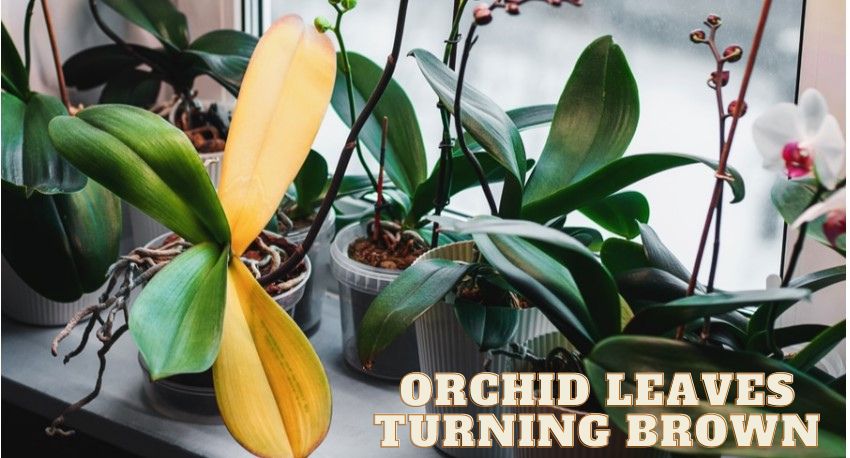
Reasons why orchid leaves turning brown
Orchid leaves turning brown for many reasons. If there is a decomposition of chlorophyll, as well as other photosensitive pigments. After that, tannins remain, which indicates the death of leaf plates.
The darkening can manifest itself in different ways. Brown color can be in the form of spots or localized along the edges. More on the main reasons why the leaves of different orchid species turn brown we describe below.

Reason 1: orchid leaves turn brown because of over-moistening or lack of moisture
Orchid leaves often take on a brown hue if they are watered abundantly, or rare and poor watering is carried out. In such cases, brown shades can be seen along the edges. Also, there are brown tips on the leaf blades. If the plant does not have enough moisture, it does not absorb nutrients.
This may cause a loss of rigidity. There are several main signs that the plant is not getting enough moisture:
- dry soil;
- brown leaf tips and edges that crunch;
- orchid leaves turning yellow;
- fading and slow-growing plants;
- brown orchid leaves become wrinkled;
- the root system becomes wrinkled, and acquires a gray tint;
- orchid leaves curl;
- aerial roots dry out.
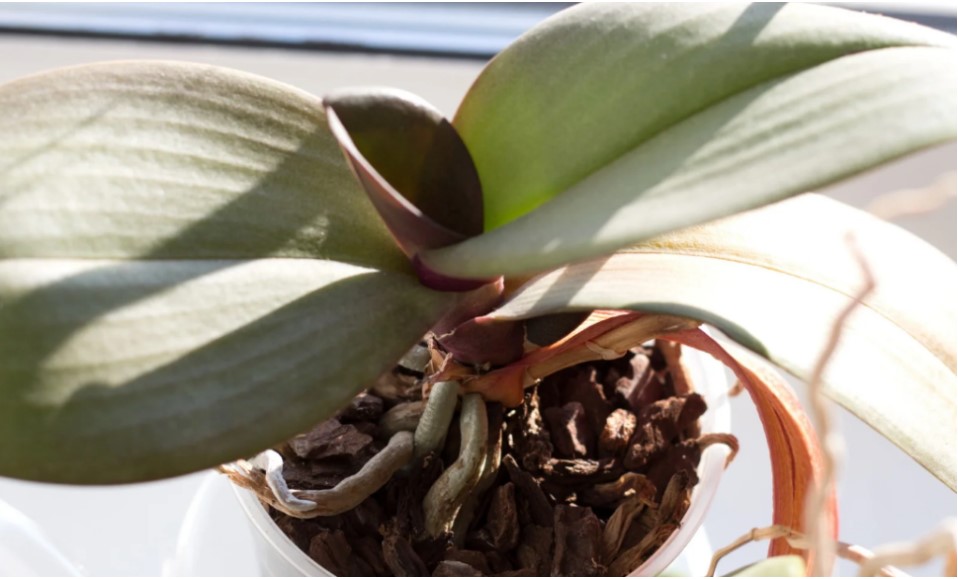
Quick Fix
First, you need to adjust the quality of watering. Try to slowly saturate the orchid plant with a nutrient medium. You need to do this until water flows out of the drainage holes.
After, watering should be carried out as the soil dries. It is important to understand that the frequency of watering depends on the genus of the orchid as well as environmental conditions.
Oncidiums and cattleyas can dry out completely, given that they have special organs that store water. Phalaenopsis need watering before the soil dries out because they do not have such organs.
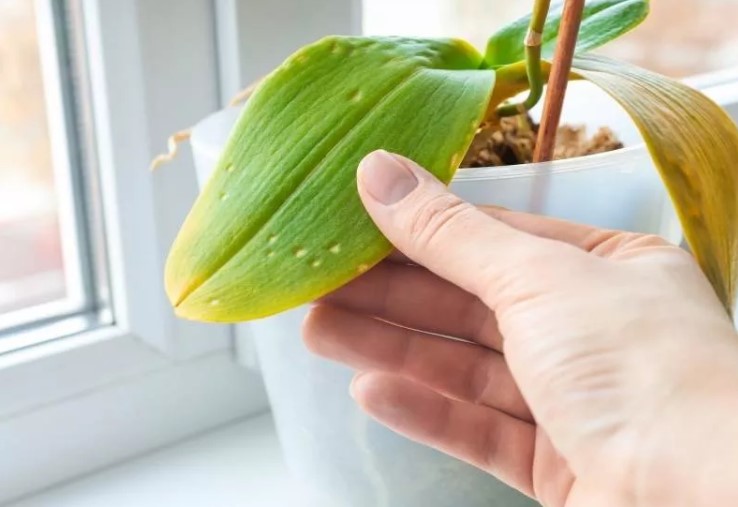
The frequency of watering must be adjusted based on the conditions in which the plant is grown. It is important to take into account the level of illumination, indicators of humidity, and air temperature.
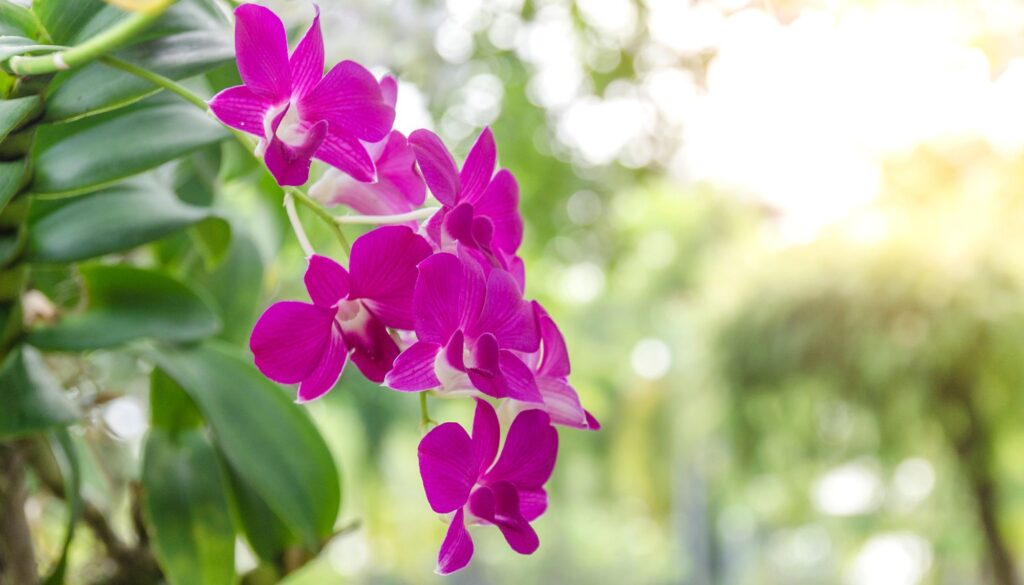
Reason 2: Illumination
It is not uncommon for the orchid leaves to turn brown if the plant is exposed to excessive sunlight. An excess of light provokes the destruction of chlorophyll, as well as sunburn. Flowers are the most vulnerable. They can become covered with wrinkles, and then wither.
Orchid’s leaves that are exposed to strong light are blotched white with dark rings. A red-violet or black tint may also appear. Of the other signs, there are yellowish edges and ends. After that, brown spots appear on the leaves.
Quick Fix
So, what do you do when orchid leaves turn brown? The orchids must be well-lit for about 12-16 hours a day. However, direct sunlight should be avoided, especially at noon. Therefore, you need to find the best place for the plant without direct sunlight.
Reason 3: diseases. The list od diseases cause that entire leaf to turn brown
It is not uncommon for the orchid leaves to turn brown if the plant is affected by fungal or bacterial infection.
- Bacterial rot. This disease affects the roots and leaves. Initially, watery spots appear that have yellow edges. After the area becomes brown or black. The dead roots must be cut out. You should also monitor the watering interval and regularly treat it with bactericides.
- Brown spotting. At first, dirty green bubbles form on the soft leaves. After that, they increase in size. In the future, they acquire a brown or black tint. It is necessary to remove infected parts, and also treat with them copper-containing bactericides.
- Black rot. This disease provokes deformation of the root system, as well as leaves. Watery spots appear on the affected areas, which have an irregular shape. After they acquire a purple-black or brown hue. The disease is quite contagious, so the plant needs to be discarded or isolated. After the infected areas are removed, fungicide treatment is carried out.
- Anthracnose. The leaves turn brown first at the tips, and then around the entire perimeter. To get rid of the disease, you need to spray the orchid plants with brown tips with systemic or protective fungicides. You also need to ensure that the air circulation is well in the room.
- Septoria. Initially, small sunken spots form on the orchid leaf plates, which increase over time and acquire a brown tint. The spots are often irregular or round. Should I cut off brown orchid leaves? It is necessary to cut off the affected areas, as well as spray with systemic fungicides.

Reason 4: Fertilizer burns the orchid leaf
It is not uncommon for leaves to turn brown if too much salt build-up. Often this happens if the plants are overfed, or if fertilizers are not properly selected. As salt accumulates, water is absorbed and the root system may be burned.
If salt has accumulated, the leaf tips and edges of the leaves turn brown. On the ground, you can see a crust of brown or white. It is also slow growth, abscission, and yellowness of the leaves. If nothing is done, the plant dies.

Quick Fix
First, you need to rinse the soil and reduce the amount of alkali. To do this, you need to pour in fresh water. This dissolves and removes the salts. The procedure should be carried out 1 time to 1-2 months.
After that, top dressing is required using balanced fertilizers. You need to use ½ or ¼ concentration. Fertilizers need to be applied 1 time in 1-2 weeks.
Reason 5: The leaves turning brown because of pests
On the bushes, you can often see signs of pests such as aphids, scale insects, mealybugs, and thrips. They are often the cause of the formation of brown spots. They can also provoke the deformation of orchid leaf plates and flowers.
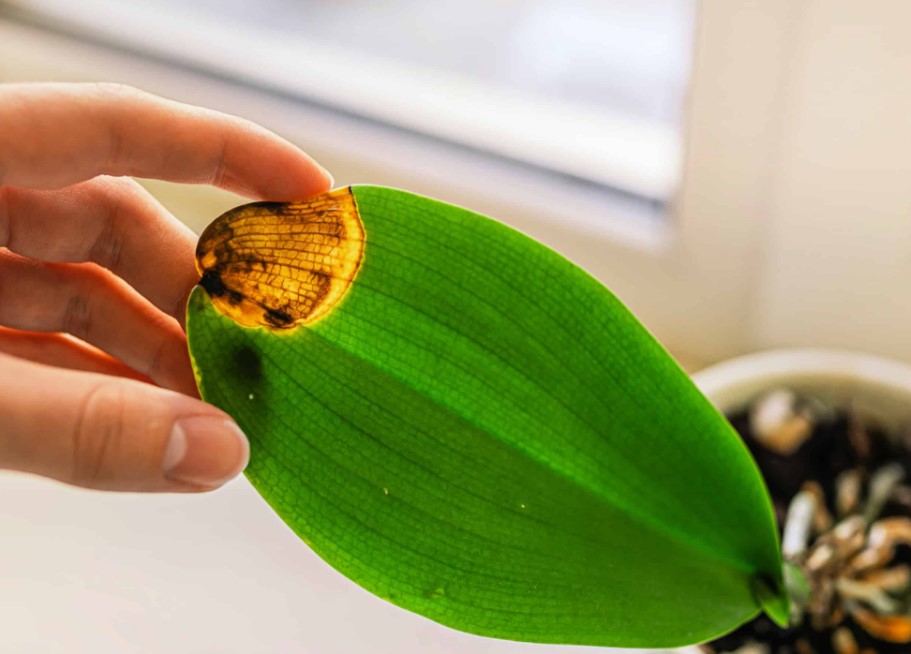
Brown spots can affect plants if mites appear. Initially, they appear as small yellow spots, which later turn brown.
Ticks are small, oval-shaped beetles. They may be pale or scarlet brown. If you look at them, they look like small moving dots. They are often located at the bottom of the sheet plates.
Quick Fix
You can fight mites with insecticidal soap. You can also purchase garden sprays or neem oil. There are already ready-made products on sale that can be used immediately after purchase.
If the mites have not severely affected the orchid bush, you can use medical alcohol. They need to moisten a cotton pad and wipe the mites from the orchid leaf plates.
Reason 6: Orchid leaves turning brown because of nutrient deficiency
Do not use balanced fertilizers to care for orchids, in which all the necessary trace elements, the leaves turn dark and become covered with brown spots. This indicates that the plant lacks nutrients.
If the orchid lacks nutrients, other signs can be noticed. The bushes are covered with yellow spots. The leaves begin to deform and growth slows down.
If the plant does not have enough potassium, there is a high probability of necrosis of the edge and ends of the leaves. These areas become dry or turn brown or black. If there is a lack of magnesium, interveinal chlorosis occurs. If the plant lacks magnesium, the leaves eventually die off.
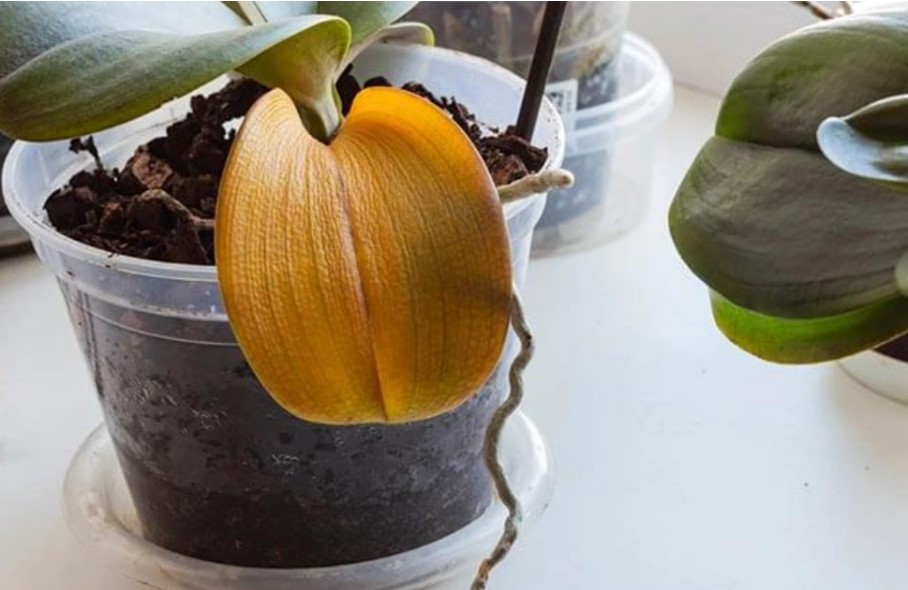
Often, a lack of nutrients provokes a loss of pigment in the leaves. If a scarlet-brown shade was noticed, then the plant needs phosphates.
Read also: Healthy orchid roots
Quick Fix
So that the plant does not face a lack of nutrients, try to use complex fertilizers. It is best if phosphorus, potassium, and nitrogen are exactly 20% each.
For more details check out the article – Why Are My Orchid Leaves Turning Brown?
Orchids are well affected by fertilizers in which NPK indicators are 30-10-10. Yes, this is not a balanced fertilizer.
However, in some brands, you can notice the content of zinc, boron, manganese, copper, and iron in the composition. This positively affects the condition of the plants.
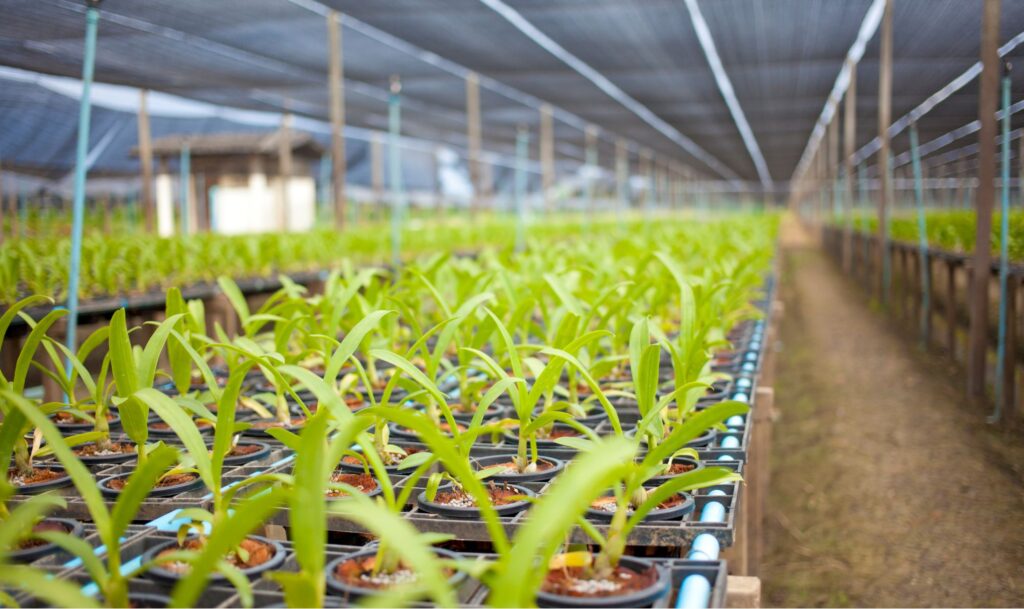
Read also: Orchid leaves wrinkled and limp
Try to start with no more than ¼ tsp of orchid fertilizer in a gallon of water. Top dressing should be done twice a month.
If the plant is deficient in magnesium or calcium, it is best to use a Cal-Mag fertilizer or an Epsom mix. This leads to a quick recovery of the plant.
Reason 7: Cold
It is not uncommon for orchid leaves to get brown if they have been supercooled. Areas saturated with water appear on the surface of the bush. After, the leaves begin to wither and acquire a brown tint.
If the plant has been supercooled, it is slowed down in growth. There are also signs of a bacterial or fungal infection.
Quick Fix
For the plant to be completely safe, it is recommended to maintain a constant temperature in the room, which is 75℉. At night, the temperature should not be lower than 65℉. However, it is still important to take into account the needs of the genus.
Some varieties that have been bred for cooler regions can withstand temperatures around 50-80℉. Intermediate-type plants should be kept between 55 and 85℉. If the orchid is warm, the indicators should be 60-90℉.
Reason 8: Water quality
If the water contains a lot of fluorine, salt, or chlorine, as observed in well water, orchid leaves turn brown. The accumulation of salts can be quite dangerous for the plant, as well as an overabundance of fertilizers.
Brown edges and leaf tips appear if a lot of chlorine and fluorine have accumulated. Often this causes tissue necrosis, especially if more fluorine has accumulated.
Quick Fix
Watering orchids should be done with filtered or rainwater. If the water contains a lot of chlorine, it can be left to settle overnight.
Can brown leaves be trimmed?
There is no clear answer because everything depends on many parameters. If the cause is not related to the disease, pruning can be carried out. If the all leaf has been affected, or there are signs of infection, shearing should be done with sterilized scissors.
Remember that brown leaves never turn green. However, you can prevent an increased infection of the bush.
What are the signs of an overwatered orchid?
If the orchid has been waterlogged, the leaves become limp or leathery. It all depends on what type of flower you are growing. Some leaves may turn yellow, and new ones may become wrinkled.
Results
As you can see, brown leaves on orchids appear for various reasons, and all of them are related to the quality of care. Therefore, first, you need to determine the cause, and then proceed to eliminate it.
Read our new article to answer the question Is it possible to save an orchid with root rot?
Read also:
- Orchid temperature
- Epidendrum orchid
- How to revive orchids
- How to grow orchids in water
- White spots on orchid leaves
What do you do when orchid leaves turn brown?
When orchid leaves turn brown, it may be due to over or underwatering, low humidity, or pests. Trim brown leaves and address the underlying issue by adjusting watering, humidity, or treating pests.
Should I cut off brown orchid leaves?
If the brown orchid leaves are completely dead or damaged beyond repair, then you can use sterilized pruning shears to cut them off. This will help prevent the spread of any problems to the rest of the plant. However, if the brown spots are minor and the leaves are still healthy overall, you can leave them on the plant.
What do Overwatered orchids look like?
Overwatered orchids may have yellowing leaves, brown or black roots, fungal growth, foul smell, and stunted growth. Adjust the watering routine to prevent further damage.
What does a dying orchid look like?
A dying orchid may have yellow or brown leaves, soft or mushy roots, no new growth, and no blooms.
Where do you cut an orchid with brown stems?
If your orchid has a brown stem, you can use sterilized pruning shears to cut it just above the lowest node that still has healthy, green leaves. This can encourage new growth to emerge from the node. If the entire stem is brown and there are no green leaves left, you can cut the stem all the way back to the base of the plant.
